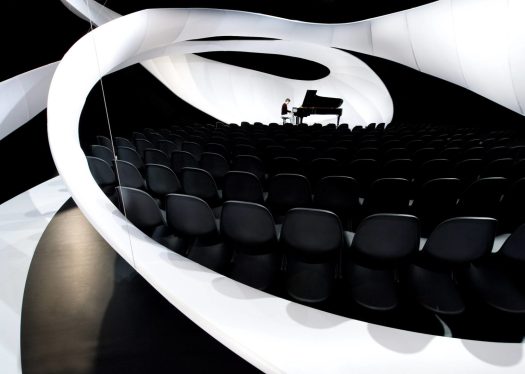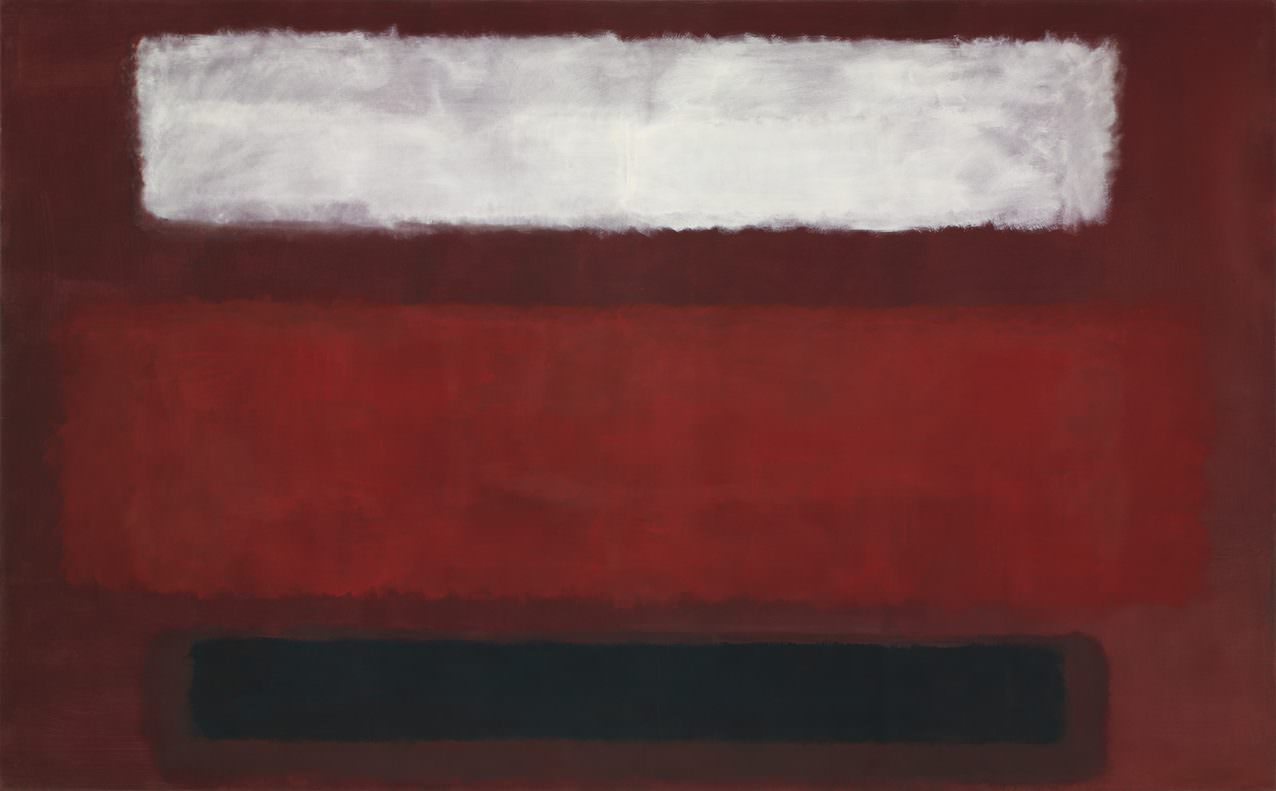Friday 10 May 2024
Bridgewater Hall Manchester
*****
A musical art installation brings ‘a stillness that moves’ to Manchester

Manchester Collective first appeared on this Blog in December 2019, a review of a concert at The White Hotel in Salford, a small and (on the evening of the performance) very cold venue. Since then, this Blog hasn’t featured the Collective, for very boring reasons – partly due to the author being distracted by writing two books and by the joys of progressive rock (which, you will pleased to hear, will still be celebrated elsewhere on this Blog). In the interim, the group has continued to innovate, maintaining the highest possible artistic standards, deservedly performing to much bigger audiences, but never compromising its musical and artistic ambition. It remains one of the most exciting chamber groups on the UK classical music scene.
In 2009, the architect Zaha Hadid created a musical art installation for Manchester Art Gallery, turning an upstairs gallery into a temporary performance space called the JS Bach Chamber Music Hall, in which small-scale works by the great German composer were played live while the audience and performers were surrounded by a continuous, snaking piece of white Lycra. Lynne Walker in The Independent described it as ‘the perfect union of sound and space.’ Last Friday, Manchester Collective created, to adapt Walker’s phrase, the perfect union of sound and visuals at the Bridgewater Hall to recreate the experience of being in the Rothko Chapel in Houston, Texas.

Using evocative lighting designed by Lewis Hall, the stage was set with a series of upright lights to suggest the corners of the Chapel, and a suspended lighting structure to suggest the shape of the roof. The visual effect, with the colours of the lighting changing to match each piece of music, was spellbinding. The audience often sat in darkness, in rapt attention as if observing a sacred ritual, with shafts of light from the stage casting mysterious shadows.

The Rothko Chapel opened in 1971, a year after the American painter Mark Rothko died. Known for his large-scale canvasses of single colours or blocks of colour, Rothko’s legacy in the Chapel was a temple of art, with 14 of his darker-coloured paintings on the walls of the octagonal building. The aim of founders John and Dominique de Menil was also to create a non-denominational chapel, open to all. According to the Chapel’s website, it provides,
‘A stillness that moves… A quiet disruption… A sanctuary for the seeker…’
The music in Friday’s concert often provided the same experience. The phrase ‘a quiet disruption’ was particularly apt for three new commissions by Isobel Waller-Bridge, Katherine Balch and Edmund Finnis. The concert took its title from a piece written in 1971 by the American composer Morton Feldman, Rothko Chapel which was first performed in the Chapel in 1972. The new commissions, scattered across the first half, were given the same brief of responding to the architecture and atmosphere of the Chapel. As Rakhi Singh, Manchester Collective’s Creative Director, said in a short introduction from the stage, it’s very unusual to hear three new works in one concert; it’s challenging to be faced with over half an hour of music of which no recordings exist yet; and all three composers brought a very different response to the brief. Hearing the pieces unfold in real time was a fascinating and rewarding challenge.
The first of the three works was No. 9 for choir, string quartet, celeste and percussion by Isobel Waller-Bridge. Viewing the Rothko Room installation at Tate Modern a while ago had a profound effect on me – standing in the middle of the room, not looking directly at the black and maroon canvasses, created a sense of oppressive claustrophobia; it was almost as if the paintings were breathing. Waller-Bridge quotes Rothko’s own words about his painting No. 9; White and Black on Wine,
‘When you turned your back to the painting, you would feel that presence the way you feel the sun on your back.’

The composer’s reaction to the painting was very striking,
‘I stood in front of this painting for a long time. Sound emanated from it.’
Rakhi Singh’s description of the new piece was that it was ‘very bold.’ There were moments when it felt as if we were watching a pagan ritual from a horror film, the lights causing members of the Sansara choir to appear in silhouette; all that what was missing was the cowls that are often worn in such rituals in films. The piece began with a simple falling motif from Sansara choir, which was soon joined by interlocking string passages as the choir reached a delicious cacophony with intense strings. The music rose to a horrifying, frenetic climax, with the ominous rumble of percussion, scampering strings and tubular bells that might remind some of the music for the 1973 horror film The Exorcist. Minimalist chanting recalled the feverish atmosphere of George Crumb’s string quartet Black Angels (1971). The clatter of drums led to the choir singing in fierce, nightmarish unison, before the music fell away with serene chords, then tone clusters that were reminiscent of music used in another film, Atmosphères (1961) by György Ligeti from 2001: A Space Odyssey (1968). A long held soprano note with more intense chord clusters ended the piece as it died away.
Rakhi Singh gave only one clue about the second commission – ‘the details are important’ – but it was helpful to know what to listen for in songs and interludes for choir (women only), harmonica, celeste and percussion by Katherine Balch. The piece has a fascinating set of influences, concepts and structural references, drawn as Balch says, from ‘a few disparate sources.’ Firstly, she adopted Feldman’s structure from Rothko Chapel, interspersing songs with instrumental interludes. Secondly, rather than using the dark colour palette from Rothko’s paintings in the Chapel, Balch was inspired by his earlier Color Field works from the 1950s which are painted in much brighter hues and warmer tones. Finally, to provide linking texts, she took words from Virginia Woolf’s essay A Room of One’s Own (1929) and using black-out poetry techniques redacted almost all the words on the page, leaving a fragmented version of the essay with only one or two words per page. She says,
‘The result resembles, in my mind, Rothko Chapel’s black triptychs – mostly monochromatic, with textural ripples.’
The piece began with overlapping bursts of voices, demonstrating strong harmonic invention. Resonant percussion led to a moving, magical section where various choir members played harmonica. It sounded as if the music was being beamed from a different dimension. A moment of profound stillness and beauty. A single, solo voice was followed by transgressive whispering and brittle percussion. Fragments of melody bloomed as the percussion became more fractured. If the devil was in the atmosphere of the Isobel Waller-Bridge piece, here the devil was in the detail of the tightly structured miniatures. The piece ended with high harmonica notes and a vocal fugue. Throughout, the virtuosity of percussionist Delia Stevens who did the work of two or three people at once, and the choir of women, was fully in evidence in a superb performance of the work.
Rakhi Singh didn’t provide any clues about the third and final Manchester premiere, Blue Divided Blue for choir, string quartet and tubular bells by Edmund Finnis. In the programme note, Finnis quoted Rothko’s description of the appropriate reaction to his paintings – they are about much more than the use of colour,
‘The people who weep before my pictures are having the same religious experience I had when I painted them.’
Finnis uses a text, ‘assembled exclusively from words found in titles of paintings by Rothko’ to create a ‘lament.’
The piece began with solo viola played by Ruth Gibson, intently going round and back on itself, leading to dense textures in the string quartet, and the choir passing the words ‘blue divided’ around from singer to singer. Calm, contemplative strings led to vocals spiralling forever upwards until they fell back again with gorgeous textures. Yearning, ambiguous chords morphed into each other, with dense choral textures slowly evolving as they came in and out of focus. The singers’ voices dropped to the depths as a busy string theme led to the final motif on tubular bells.
It was a privilege and a profound pleasure to hear three such contrasting new works, and before the interval Singh made an impassioned plea for the importance of new music. All the rest of the music in the concert has been performed and recorded elsewhere, but was beautifully programmed, as is always the case with Manchester Collective, to create a unique, special experience.
The concert began with the choir singing Solfeggio (1963) by Arvo Pärt, a fairly early work in serialist style before the composer developed his later tonal. bell-like style, the tones floating on the air to belie the formal structure. Nick Trygstad immaculately performed two works for solo cello, the plainsong-like Ave Maria (1972) by Giacinto Scelsi, and 7 Papillons: No. 2 by Kaija Saariaho, graphically describing the fluttering first flight of a butterfly. But perhaps the highlight of the first half, apart from the three substantial new commissions, was Vespers for Violin (2014) by Missy Mazzoli superbly performed by Rakhi Singh on a heavily echoed instrument, with supporting electronics including a recorded female voice that lurk unsettlingly below the soaring, ecstatic violin line, suggesting a twisted ritual remembered in a fever dream.
The second half of the concert was devoted to Feldman’s Rothko Chapel, another piece with ritualistic elements that at times were similar in emotional depth to a later work, The Protecting Veil (1988) by John Tavener. Both works feature a solo string instrument, viola and cello respectively. In concert, they create a sense of communal contemplation, a collective gathering of thought. Appropriately then, after the enticingly challenging nature of the earlier works in the concert, the piece ends with a simple folk melody, a restatement of the basic humanity that lies behind the spirit of the Chapel itself, sending the audience out from the reverential darkness of the Chapel to the bright sunshine of a Mancunian evening. An uplifting ending to a stunning concert.
Creative team
Rakhi Singh – Creative Director
Tom Herring – SANSARA: Artistic Director
Lewis Howell – Lighting Designer
Tomoya Forster – Sound Engineer
Kate Green – Producer
Declan Kennedy – Producer
Alex Benn – Stage Manager
Manchester Collective
Rakhi Singh – Violin
Donald Grant – Violin
Ruth Gibson – Viola
Nick Trygstad – Cello
Delia Stevens – Percussion
Katherine – Tinker Celeste
SANSARA
Lucinda Cox – Soprano
Fiona Fraser – Soprano
Daisy Walford – Soprano
Clover Willis – Soprano
Laura Baldwin – Alto
Amy Blythe – Alto
Anna Semple – Alto
Jack Granby – Tenor
Will Wright – Tenor
Piers Connor Kennedy – Bass
Ben Tomlin – Bass
Tom Herring – Conductor, Bass


